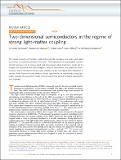Two-dimensional semiconductors in the regime of strong light-matter coupling
Abstract
The optical properties of transition metal dichalcogenide monolayers are widely dominated by excitons, Coulomb-bound electron–hole pairs. These quasi-particles exhibit giant oscillator strength and give rise to narrow-band, well-pronounced optical transitions, which can be brought into resonance with electromagnetic fields in microcavities and plasmonic nanostructures. Due to the atomic thinness and robustness of the monolayers, their integration in van der Waals heterostructures provides unique opportunities for engineering strong light-matter coupling. We review first results in this emerging field and outline future opportunities and challenges.
Citation
Schneider , C , Glazov , M M , Korn , T , Höfling , S & Urbaszek , B 2018 , ' Two-dimensional semiconductors in the regime of strong light-matter coupling ' , Nature Communications , vol. 9 , 2695 . https://doi.org/10.1038/s41467-018-04866-6
Publication
Nature Communications
Status
Peer reviewed
ISSN
2041-1723Type
Journal item
Description
C.S. thanks the ERC for support within the project Unlimit2D. M.M.G. is grateful to the Russian Science Foundation (Grant No. 17-12-01265). T.K. gratefully acknowledges financial support by the German science foundation (DFG) via grants KO3612/1-1 and KO3612/3-1. S.H. is grateful for support within the EPSRC “Hybrid Polaritonics” Grant (EP/M025330/1). B.U. thanks ANR 2D-vdW-Spin and ERC Grant No. 306719 for financial support.Collections
Items in the St Andrews Research Repository are protected by copyright, with all rights reserved, unless otherwise indicated.

